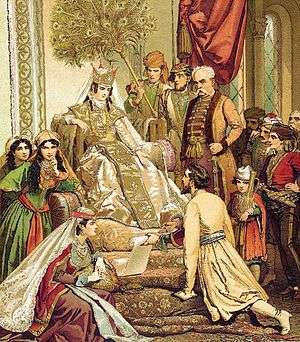Ivane I Mkhargrdzeli
| Ivane Mkhargrdzeli | |
|---|---|
| Ruler of Dvin | |
| Successor | Avag Mkhargrdzeli |
| Born | unknown |
| Died | 1227 |
| Buried | Akhtala Monastery |
| Noble family | Mkhargrdzeli |
| Father | Sargis Mkhargrdzeli |
| Religion | Georgian Orthodox Church |
Ivane Mkhargrdzeli (died 1227 AD) was a Georgian-Armenian[1] noble and one of the generals of Tamar's army during the late 12th and early 13th centuries. He was the ruler of feudal lands in the Kingdom of Georgia.[2]
The eastern areas Bjni, Gegharkunik, Vayots-dzor, Artsakh, Siunik, Nakhichevan, Dvin and Yerevan were under the jurisdiction of the atabeg Ivane Mkhargrdzeli and his son Avag. First Dvin and later Bjni were centres of this division. The subjects of Ivane’s family were the Orbelians, Khaghbakian, Dopians, Hasan-Jalalyanand others.
Biography
Ivane and his father Sargis supported the rebellion of their suzerain Orbeli family and Prince Demna in 1177, however they soon sided with George III of Georgia and fought for the monarchy against the insurgents. The uprising was suppressed, and King George III elevated the Mkhargrdzeli family.
Following the death of George III, there was considerable opposition to Tamar's succession, however she gradually expanded her own power-base and elevated her loyal nobles to high positions at the court, most notably the Mkhargrdzeli.[3] She gave presents to Ivane and his elder brother Zakaria, and made them a member of the Darbazi. During a revolt of Queen Tamar's disgraced husband, George the Rus', around 1191, Ivane and Zakaria Mkhargrdzeli were one of the few nobles who remained loyal to the queen. In exchange Queen Tamar granted him possessions over Dvin, Vaspurakan and Gelakun as a fief and elevated to the office of msakhurtukhutsesi. Ivane commanded the Georgian army for almost three decades, achieving major victories at Shamkor in 1195 and Basian[4] in 1203. Around the same time, Ivane converted to Georgian Orthodox Christianity, while his elder brother Zakare remained Armenian Apostolic in faith. Tamar honored Ivane with the position of atabag (tutor), the position that became prominent was respected even more than certain Eristavis (duke).
During the siege of Ahlat Ivane Mkhargrdzeli accidentally fell into the hands of the al-Awhad on the outskirts of Akhlat. He was taken prisoner and by way of ransom had to cede several castles, to liberate 5000 Muslim prisoners and to promise the hand of his daughter Tamta to his captor.[5] Ivane commanded one of the most devastating expeditions against the Georgian mountainers in c. 1212, who had rebelled against the attempts of transplanting feudal practices and forceful Christianization. The contemporary chronicle recounts a bloody three-month campaign of pacification, that left several villages and shrines destroyed.
During Khwarezmian invasion of Georgia in 1225, Dvin was ruled by the aging Ivane, who had given Ani to his nephew Shanshe, son of Zakare. Ivane Mkhargrdzeli commanded Georgian army at the battle of Garni, he placed his rival commanders in charge of the vanguard of the Georgian army and did not allow main army to fight and ordered his troops to abandon the battlefield entirely, leaving the other two commanders Shalva and Ivane Akhaltsikheli in their enemies' hands. The results of betrayal was that a quarter of the Georgian army was annihilated, leaving the country poorly steeled against an upcoming Mongol invasion. The capture of Dvin brought about the end of Georgia's medieval heyday. Dvin was lost, but Kars and Ani was kept.[6] His family went in decline with the Mongol invasion of Georgia.[7]
References
- ↑ Bournoutian, George (December 15, 1986). "Armeno-Iranian relations in the Islamic period". Encyclopædia Iranica.
Under the leadership of the Armenian generals Zakʿarē and Ivanē, who had assumed the high command of the Georgian Army...
- ↑ Shoshiashvili N. Georgian Soviet Encyclopedia, Book 7, page 271. Tbilisi 1984
- ↑ Suny 1994, p. 39.
- ↑ Alexander Mikaberidze, Historical Dictionary of Georgia, (Rowman & Littlefield, 2015), 184.
- ↑ V. Minorsky, Studies in Caucasian history, Taylors Foreign Press, 1953. pg 90-93
- ↑ Minorsky, Vladimir (1953). Studies in Caucasian History. New York: Taylor’s Foreign Press. pp. 102–103. ISBN 0-521-05735-3.
- ↑ Redgate, Anne Elizabeth (2000). The Armenians (First ed.). Massachusetts: Blackwell Publishers Inc. pp. 225–26, 258, 261. ISBN 0-631-22037-2.
